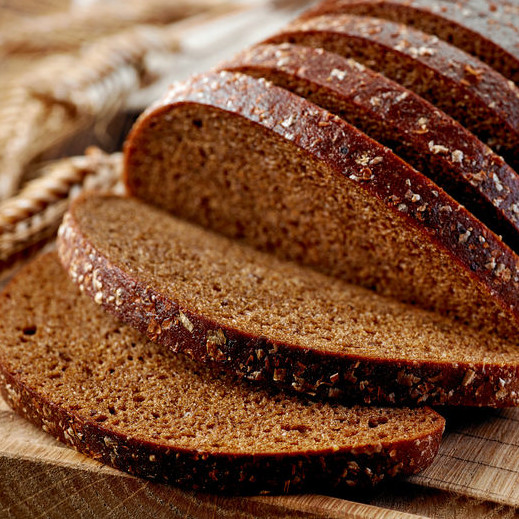
Rye Bread
What is Rye Bread?
Rye bread is a variety bread that has a distinct flavor and dense texture. It is mainly produced and consumed in Northern and Eastern Europe. The best known rye breads include:
- Pumpernickel: a soft bread made using very coarse rye meal and a sourdough process
- Crisp bread (knackebrot): made from wholemeal or flaked rye and is yeast fermented
Breads made with 100% rye flour are common in Europe while in the U.S., they are a combination of wheat and rye (20%) flours.
Origin
Rye bread is very popular in Europe and Germany. The grain is believed to have originated in Asia in prehistoric times and was brought to Europe in the Middle ages where it was widely used in breadmaking and producing alcohols. Migrants from Northern Europe brought rye bread to the U.S.
How is rye bread made?
Depending on the type (light, medium or dark) and amount of rye flour used, rye breads can vary in crumb color (white to very dark) and taste (mild distinctive to very strong acidic taste). Rye breads also vary in shape (round to elongated) and can include caraway seed or other spices.
A typical bread formula containing 25% rye flour using sponge dough and 64% hydration:1
| Sponge | |
| Ingredient | Baker’s % |
| Clear flour (wheat)* | 35.0 |
| Medium rye flour | 20.0 |
| Water | 40.0 (67% on sponge side) |
| Vital wheat gluten (VWG) | 2.5 |
| Compressed yeast | 3.0 |
| Mineral yeast food | 0.5 |
| Dough | |
| Ingredient | Baker’s % |
| Clear flour (wheat)* | 40.0 |
| Medium rye flour | 5.0 |
| Water | 24.0 |
| Vital wheat gluten (VWG) | 2.0 |
| Salt | 2.0 |
| Molasses (first grade) | 4.0** |
| Shortening | 3.0 |
| Dough conditioner (strengtheners / oxidizers) | 0.5 |
| Ground caraway seed | 1.0 |
* Protein content >13.5%
Processing steps
- Ingredient scaling.
- Mixing (sponge). Mix sponge ingredients until well incorporated at room temperature.
- Sponge fermentation. Allow to ferment 3–4 hours at room temperature.
- Mixing (dough). Mix (1st speed) for 1 min. Then add sponge and mix 1 minute.
- Continue mixing (2nd speed) until development. Due to dough low mixing tolerance, shor mixing time is recommended.
- Higher levels of rye flour require shorter mixing time/low speed.
- Dividing and rounding. Dough should be dry and stiff to avoid excessive oiling or flour dusting; lower conveying speeds should be also be used.
- Moulding. Given the lack of dough elasticity, adequate moulder settings should be used (roller gap, side guide rails, etc.).
- Final proofing. Low tolerance of rye dough requires that dough pieces are proofed at 92–95˚F (33–35˚C); 85% RH for 30–40 min (compared to 60 min for white pan bread). The higher the rye flour content the shorter the proofing time.
- Egg washing (manual or automated sprayers).
- Scoring (control loaf splitting).
- Baking. Rye breads are baked in pans, screens, or as free standing loaves (hearth) at 425–450°F (218–232°C) to an internal temperature of 204°F (95°C).
- Cooling to loaf internal temperature of 95–105°F (35-40°C) before packaging.
- Bagging or packaging.
Nutrition
Because rye is mostly consumed as a whole grain, its bread is very rich in dietary fiber and bioactive phenolic compounds. Satiating effect of rye products (bread, porridges, etc.) is well-documented. Recent studies indicate that some of these products can delay hunger by up to 8 hours after consumption.4
Application
- Absence of glutenins in rye results in doughs which lack cohesive gluten matrix and breads with dense texture. Addition of vital wheat gluten can improve dough elasticity and reduce excessive extensibility.
- The absence of gluten-forming proteins in rye flour limits the amount of rye flour that can be incorporated into bread doughs.
- Abundance of arabinoxylans in rye flour contributes to poor dough performance (high water absorption and stickiness).2,3
- Low level of damaged starch is reflected in the flour’s high enzymatic activity compared to wheat flour (unmalted).
- High rye flour levels result in low volume breads. The lighter the flour color, the less intense is rye flavor in the baked product.
- Staling is not a common concern in rye breads (acidity causes starch to be more resistant to retrogradation).
FDA regulation
There is no Standard of Identity for rye bread.
References
- Moore, T.R. “Breads.” Encyclopedia of Food Grains, 2nd edition, Volume 3, Academic Press, Elsevier Ltd., 2016, pp. 8–17.
- Finnie, S., and Atwell, W.A. “Composition of Commercial Flour.” Wheat Flour, 2nd edition, AACC International, Inc., 2016, pp. 31–37.
- Arendt, E.K., and Zannini, E. “Rye.” Cereal Grains for the Food and Beverage Industries, Woodhead Publishing Limited,, 2013, pp. 220–238.
- Isaksson, H., Tilander, I., Andersson, R., Olsson, J., Fredriksson, H., webb, D.L. and aman, P. Whole grain rye breakfast-sustained satiety during three weeks of regular consumption. Physiol. Behav. 2012, 105, 3, pp. 877-884.

